How to plant, grow and care for blackberries in the open field
Blackberries are often called black raspberries. Although these plants are relatives, they are different in cultivation techniques. Culture is rare in the gardens of European territory, but in America it is very popular. We have a blackberry settled in the forests, on the banks of reservoirs. But they are already beginning to cultivate the berry in the gardens. And here in order to achieve good harvests, you need to know how to care for blackberries.
Content
- 1 Description of garden blackberry
- 2 Popular varieties
- 3 Blackberry breeding methods
- 4 How to plant a culture correctly
- 5 Landing scheme
- 6 Transplanting blackberries to a new location
- 7 General rules for caring for blackberries
- 8 Disease and pest control
- 9 Harvesting blackberries
- 10 Caring for blackberries after fruiting
- 11 Why does not it bear fruit
Description of garden blackberry
Garden blackberries can be recognized by:
- powerful rhizome;
- flexible branches covered with small thorns or without thorns;
- trifoliate green leaves with denticles along the edges;
- white flowers with a pleasant aroma that attracts bees;
- black berries, consisting of drupes and a white stalk, sometimes with a bluish bloom.
Most often, blackberries are grown in central Russia, although they are found beyond the Urals.
Popular varieties
Blackberry breeding is successful, therefore there are various plant varieties on the market:
- Thornless Tonfri is known for its unpretentiousness, frost resistance.
- Polar, besides frost resistance, gives high yields of sweet berries.
- On the numerous branches of the Chester bush, an abundance of black fruits ripens.
- Kiov's large berries are sweet, juicy and stored for a long time without losing their presentation.
- BlackBerry Black Magic belongs to the remontant species, which manage to produce crops all season in the southern regions.
- Ruben blackberries ripen early, but can die from return frosts.
Each gardener can choose a suitable variety, taking into account the climate and weather. There are also plants with long, 4-5 meters, shoots and compact ones - 2 meters.
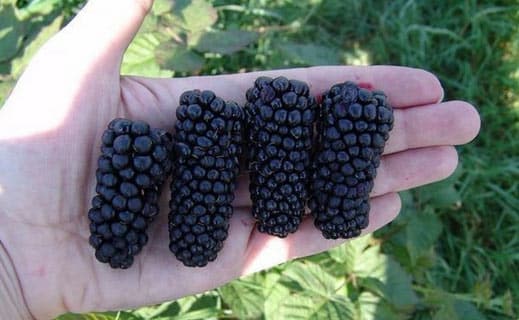
Blackberry breeding methods
You can increase the blackberry plantation by reproduction. Usually, the procedure is performed in the fall, although it is possible in the spring and even in the summer. A novice gardener can also get healthy new plant specimens.
Layers
Horizontal layers are bent to the soil surface, sprinkled with earth. And so that they do not rise, they pin. You can fix the shoot just with a stone. The growth of the branch is stopped by cutting off the top. Also sprinkle with mulch. Be sure to water it.After 2 months, you can separate the child branch from the mother branch, since it has already taken root. The seedling is cut off and transplanted to a new location.
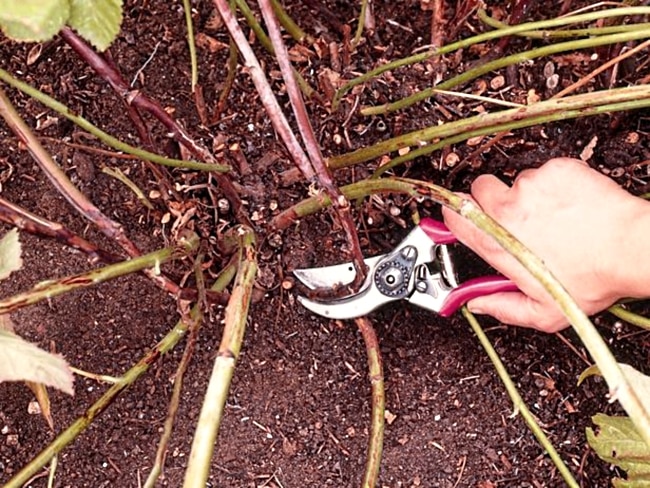
Apical shoots
Annual cuttings are cut, leaving 2-3 buds on them. It is better to tear off the leaves and then place the shoots 15 centimeters long in a cool place. In February, they are taken out and placed in the water. At the same time, the upper kidney looks down and is in the water. It is necessary to continually add liquid as it evaporates. When a sprout with roots appears from the bud, it is separated and placed in the ground. Similarly, all the kidneys are awakened by placing them in turn in water.
Offspring
You can expose the root system of the blackberry in the fall and cut the cuttings 1.5 centimeters thick and 6-9 long. They are stored in a bag in a cellar or refrigerator. Then at the end of winter they germinate by immersing the container in the ground. You can cover containers with foil for a greenhouse effect. Blackberry seedlings will take root and release leaves. In April, they are planted in the garden.

Cuttings
For cutting blackberry cuttings, annual lignified shoots are suitable. The planting material reaches 40 centimeters in length. It can be kept in the winter by burying it in the ground, or in the cellar by wrapping it in a bag. In this case, the cuttings must be ventilated. In the spring, after the snow melts, the branches are slightly cut off and planted. A film is pulled from above, preferably black. When the formation of roots occurs, they organize the planting of shoots.
Seeds
Purchased blackberry seeds are planted either in spring or autumn. A seed is capable of awakening in soil heated to 25 degrees Celsius. Place the seeds for seedlings in peat tablets or pots with nutritious soil. The seeding depth of blackberry seeds is up to 4 millimeters. And the distance between them is 3 centimeters. Water the seedlings regularly. And when 4 real leaves appear on them, they are planted in the beds.
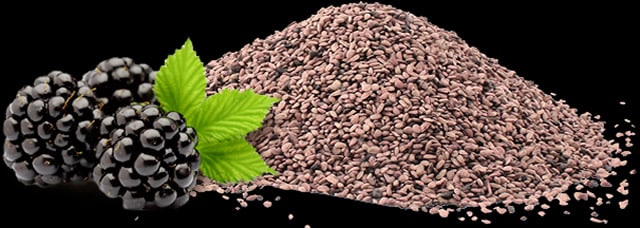
How to plant a culture correctly
Growing blackberries requires adherence to agricultural rules. If the seedlings are not planted on time, they may die. The plant needs an appropriate soil. And the distance between the bushes is selected optimal so that the plants have enough food and water.
Planting dates for blackberries
Unlike other Rosaceae, brambles are best planted in the spring when the soil warms up well. At this time, planting will be successful in areas with early frosts and severe frosts.
In autumn, you can plant in areas with a warm or temperate climate. Depending on the region, shoots are planted from the second half of October to the end of November. To grow a culture successfully, it is necessary to prepare a site for it in advance.
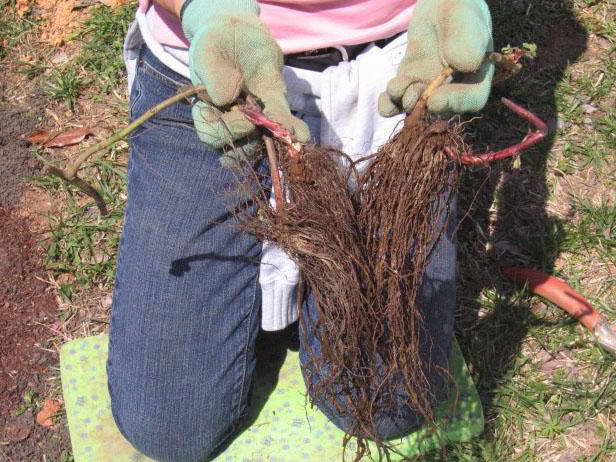
Predecessors
Not every place in a summer cottage is suitable for berry culture. The plant needs a lighted area with fertile soil. Do not plant where vegetables once grew. It is necessary to restore the balance of soil bacteria after garden plants. And this will take 3-4 years.
Of the predecessors of blackberries, the best will be legumes, cereals, which will saturate the soil with useful elements.
Preparation of supports
The trellis for the blackberry garter is prepared in advance. The columns are dug in along the edges of the intended bed. For them to hold better, it is necessary to deepen into the ground by 50 centimeters. The height of the posts reaches 2 meters. The wire is pulled in parallel rows in 2 layers at a height of 70 centimeters.

Preparing a site for planting a seedling
The culture feels great on a personal plot with well-drained soil. In addition, the place for the blackberry should be:
- with groundwater bedding 1.5 meters from the surface;
- well cleared of weeds;
- lit by the sun;
- protected from cold winds;
- filled with nutrients.
It is imperative to determine what kind of soil on the site: acidic or alkaline. A soil with a neutral pH is suitable for the berry.The depleted soil is dug up and humus and mineral fertilizers are applied. Slaked lime is added to neutralize acidity.
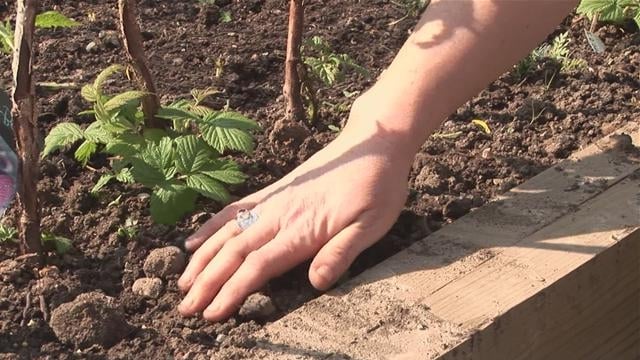
Distance between bushes
Planting begins by digging holes, which are prepared in 3-4 weeks. The branched root system of the plant needs pits measuring 35 x 35 x 30. The gaps between the bushes should be 1 meter for erect blackberry species and 1.5-2 meters for creeping ones. Rows of brambles are placed 2 meters apart.
Landing scheme
According to the step by step instructions:
- 5 kilograms of humus, superphosphate and potassium salt are introduced into the landing holes;
- after mixing the nutrient mixture with the soil, fill the pits by 2 thirds;
- the seedling is held vertically, straightening the roots;
- sprinkle the soil, slightly tamping;
- deepen the basal neck by no more than 2 centimeters.
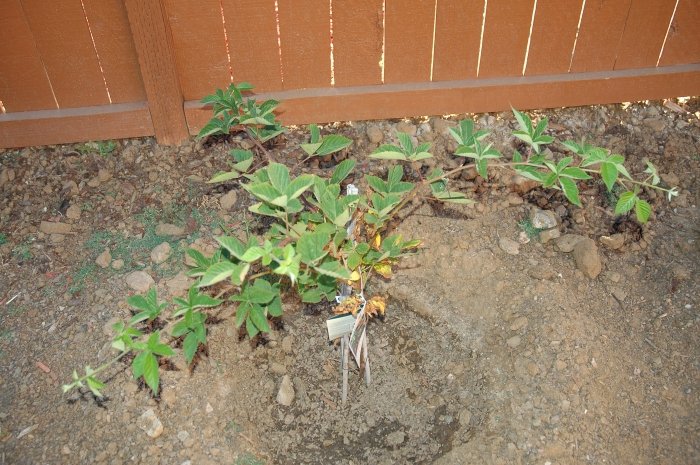
It is better to plant a plant together. After planting, a notch should remain around the shoot. Watering and feeding of crops will be carried out in it at the dacha. If the seedlings were prepared independently, at home, then they are placed in a permanent place under the film for adaptation. After all, the transition to open ground will be painful for them.
Transplanting blackberries to a new location
In the spring or fall, you can transplant the blackberry shoots to a new location. A transplant is necessary when:
- The plantation has been growing in one place for more than 10-12 years.
- The soil is contaminated with pathogenic fungi.
- The soil is oxidized or salted.
- The site has turned into a swamp.
- The conditions are not suitable for the growth of blackberries.
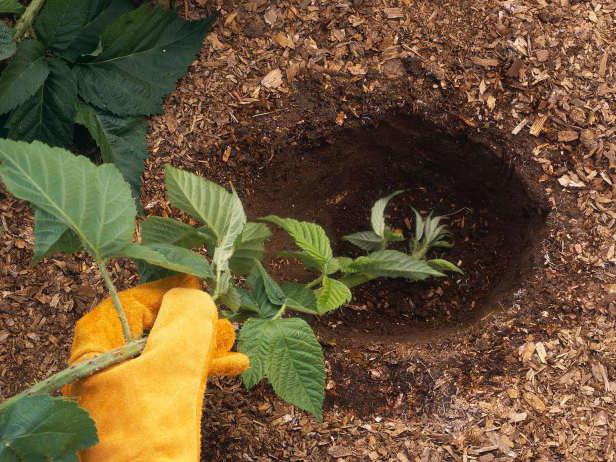
Prepare for the transplant in advance. They dig up the garden bed, add nutrients. For the berry to take root better, you must follow the planting instructions.
General rules for caring for blackberries
The berry agrotechnology includes the usual procedures. Most of all, care is required when the shrub begins to bloom, to set fruits. Particular attention is paid to blackberries in July when the fruit ripens. Collect them as they reach consumer ripeness. In August, berries are still developing. For some varieties, it lasts all September. In the summer there is enough work on the plantation. It consists in loosening, weeding, feeding. Improves yields and shrubbing to the trellis.
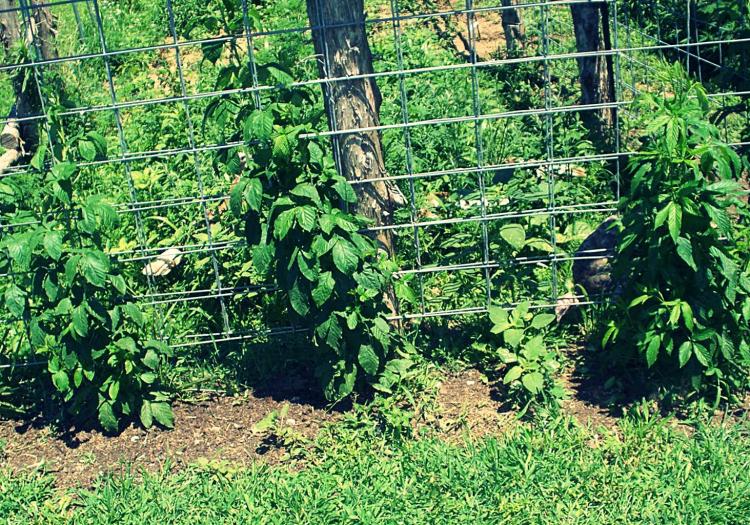
Watering, loosening and mulching blackberries
The condition of the soil is important for the growing season of the blackberry. Berry beds are often moistened in the first month after planting. The plant needs watering during the ripening of the berries. Although the crop is drought tolerant, without sufficient moisture, the fruits will be small and tough. For moistening, use settled water. Watered in the grooves located between the rows of brambles.
Loosening and weeding are constantly carried out between the rows of the berry. This makes it possible for plants to receive the elements necessary for development faster. Mulching can kill 2 birds with one stone: both retain moisture and stop the growth of weeds. After planting, mulch is scattered around the stems in a layer of 6-8 centimeters, using needles, sawdust, straw or peat, humus.

Pruning
One of the important points of berry care is pruning: both formative and sanitary. The procedure should be carried out constantly, so as not to stop fruiting, to increase berry yields.
When to conduct
From the first year of life, the inflorescences are removed from the bushes. Then the next spring, before the buds awaken, the shoots are cut off, leaving them 1.5 meters long. For 2-3 year old plants, spring pruning will be mandatory. It will give the opportunity to heal the bushes after winter, to induce the shoots to bear fruit. In autumn, they are pruned in order to lighten the crown, eliminate its thickening.

Formation of an upright bush
Blackberry bushes at 3-4 years of age should not have more than 10-12 annual shoots, not counting fruiting ones, otherwise the yields will decline. Therefore, excess processes break off at the ground. There is a need to remove those branches that are weak and densely located.The branches should be 5-7 centimeters apart from each other. Thinning is done before the flowering of blackberries.
The tops of annual shoots can be shortened by 10 centimeters in early spring. Then germination will go faster into the fruiting shoots of the buds located below.
Formation of a bush of creeping varieties
When pruning branches, root suckers, the strongest, are preserved. Leave them at 12-15 pieces per running meter. The rest, located more than 15 centimeters from each other, are removed. Shortening the branches can lead to increased berry yields. In autumn, dry branches, as well as sick and thin branches, are broken off.
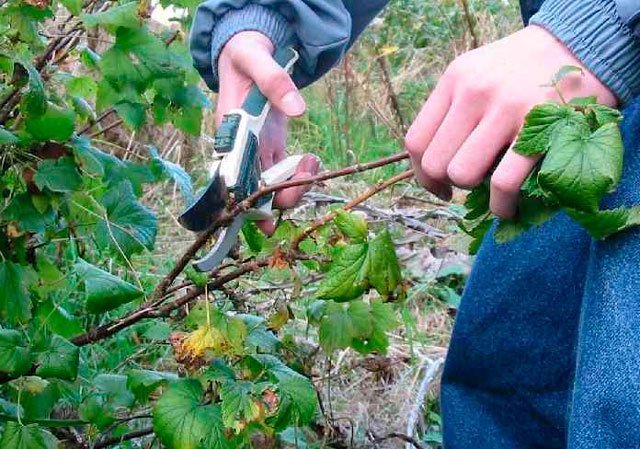
Fertilizing culture
The annual fertilization of the blackberry plantation will increase the crop yield. If mulch acts as an organic top dressing, then in the spring it is necessary to add ammonium nitrate, dissolving 15-20 grams per square meter in 5 liters of water. A week before the berries ripen, the bed is spilled with mullein, diluted in a 1: 6 ratio, or bird droppings - 1:15. For 2-3 bushes it takes a bucket of solution.In the fall, you need to feed the plants with superphosphate and potassium salt. Wood ash is also suitable, 50 grams per meter.
Shelter for the winter
In the southern regions, blackberries do not need to be prepared for winter. But where the temperature will drop below 20 degrees, it is imperative to cover the berry bushes. To do this, remove the branches of the plant from the support, bend them to the ground. You can sprinkle the tops with soil so that the shoots do not straighten. It is best to sprinkle the bushes with dry hay, straw, and throw a non-woven material on top. Be careful not to break off the blackberry shoots. It is necessary to prepare plants for wintering during the period of the beginning of a decrease in temperature during the day to -1 ... -3 degrees.
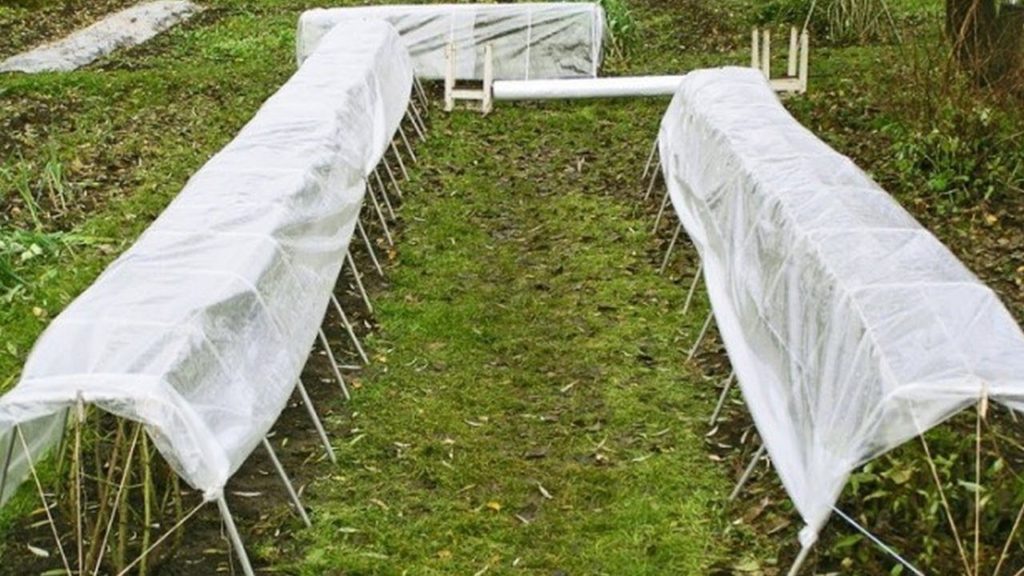
Disease and pest control
Fungal diseases spread on blackberry plantations during the humid periods of summer. Plants get sick more often:
- anthracnose;
- white spot;
- botrytis;
- powdery mildew.
Among the drugs that fight pathologies, those that contain copper are more effective. For the prevention of diseases, it is necessary to prune in time to eliminate the thickening of the bushes. Loosening the row spacing up to 5 times per season will destroy pathogenic microorganisms in the soil.
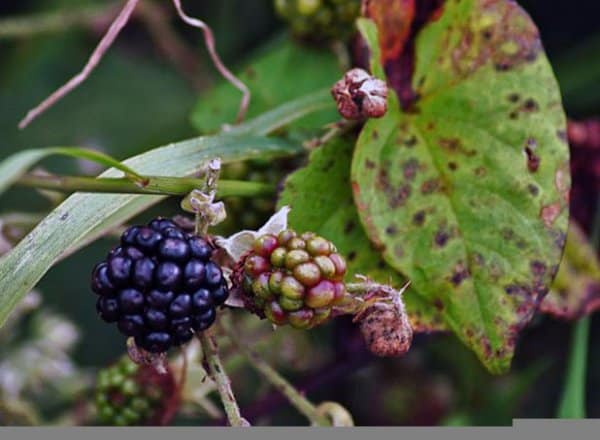
Of the pests, they prefer to parasitize on blackberries aphids, spider mites, weevils. They are fought with both insecticide treatment and folk remedies.
Harvesting blackberries
Ripening of berries occurs in the 2nd year after planting. They ripen for 35-40 days, so they are gradually removed from the bushes. Better to do a 3-5 day interval in harvesting. They pick berries without a stalk, putting them in baskets. It is not recommended to pour the blackberries from the dishes into the dishes, as they will crumple, leak out of juice and lose their presentation. Blackberries are not stored for long, so it is better to process them into jam, compotes, wine. You can freeze berries and in winter feast on blackberry pies, jelly.
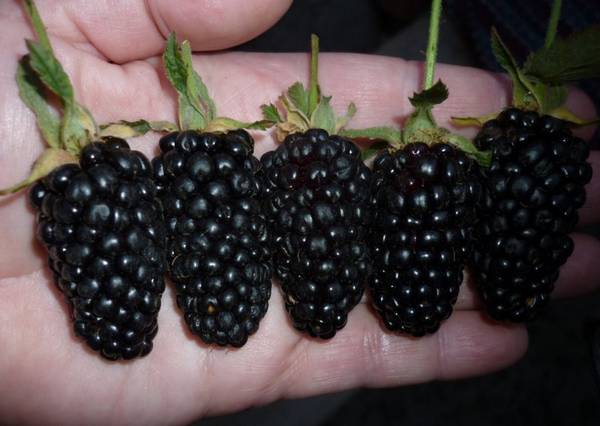
Caring for blackberries after fruiting
After collecting all the berries, it is necessary to start preparing the bushes for winter. Be sure to free the shoots from the garter, which is installed when the bushes begin to bear fruit. The plantation is well watered, creating the possibility of charging the soil with moisture. If the soil is depleted, then it is necessary to saturate it with fertilizers containing phosphorus and potassium.
You can use wood ash by embedding it in the grooves of the rows.
First, the sprouted shoots are cut off, and the soil around the bushes is mulched with peat or sawdust. They lay the shoots on the ground, sprinkling the tops with earth or hanging a load on them. It remains to sprinkle the bushes with straw or sawdust, cover with spruce branches or material.
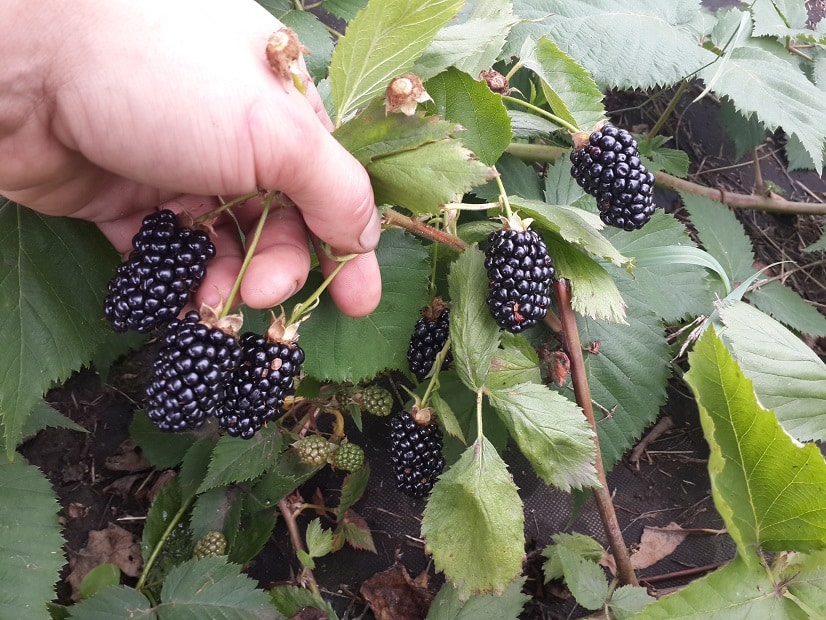
Why does not it bear fruit
The emergence of a situation when the blackberry grows, but the adult plant does not have berries, is due to the fact that;
- climatic conditions are not suitable for the selected plant variety;
- the bushes are constantly in the shade;
- pathogenic microorganisms and pests negatively affect the development of the berry;
- the soil is dry, lacking moisture and nutrients;
- soil with high acidity or highly saline.
In the absence of fruits on the blackberry, it is better to replace the variety or plant it on another site suitable for the culture.
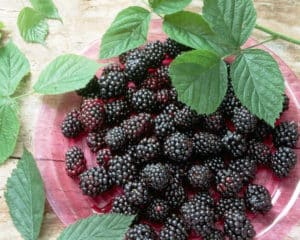




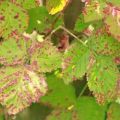

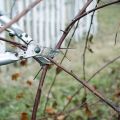
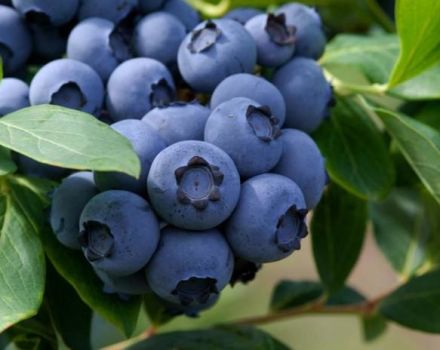
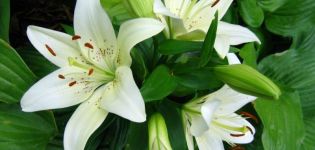
It is a thermophilic berry, so plant it only after the soil has warmed up well. I planted cuttings in the middle of spring. Do not use highly aggressive poisonous agents